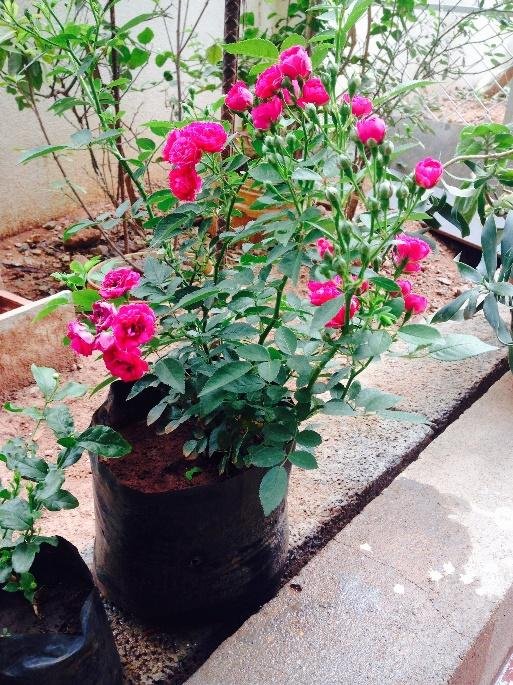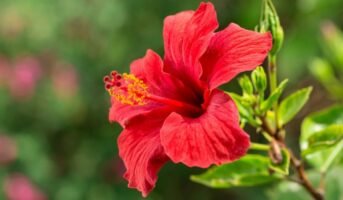Popularly called miniature roses, Button Roses are popular flowering plants widely known for their stunning blooms. Growing beautiful flowers in a plethora of different colours, Button Roses are one of the most loved ornamental plants grown in home gardens. In addition to its immense ornamental value, the plant also has various culinary and medicinal uses. So, read on to learn more about growing and maintaining Button Roses in your backyard.
What is a Button Rose plant?
A species of flowering shrub belonging to the Rosaceae family and genus, Button Rose, or Rosa ‘Bright as a Button,’ is one of the most popularly grown flowering plants and is predominantly native to Asia. Tiny rose is another name for this perennial flowering plant. It produces flowers all year long except for those varieties that have adapted to produce enormous, multiple-hued blooms for commercial production.
Rose flowers have a strong fragrance on their own. One of the most widely planted decorative flowering plants, roses come in several thousand different varieties and are grown all over the world. Button Roses became well-known because of their lovely flowers and seductive aroma. Since they are durable and simple to maintain, they have maintained their popularity. Although Button Roses may be put on a show for several seasons, they do need regular care due to their higher susceptibility to pests and disease. Button Roses come in a variety of vivid colours, including red, yellow, pink, white, and orange.
Button Rose: Key facts
| Family | Rosaceae |
| Common name | Button Rose, Miniature Rose |
| Plant category | Perennial shrub |
| Native | Asia |
| Foliage characteristics | Medium leaves |
| Flower characteristics | Erect, showy |
| Flower colour | Red, yellow, pink, white & orange |
| Sunlight | Full |
| Maintenance | High |
| Soil | Well-drained, clay or loamy soil |
| Water range | Normal to Moist |
| Temperature | 20 to 35 degrees C |
| Fertiliser | Organic fertiliser |
| Toxic | Yes |

Source: Pinterest
See also: What is Hibiscus and how to grow it in your home?
Button Rose: Physical description
-
- Button Roses are erect, climbing, or trailing shrubs with numerous prickles of various sizes and forms that are typically referred to as thorns.
- The leaves are complex (i.e., feather-shaped), alternating, and usually have oval, acutely toothed leaflets.
- Button Roses often have multiple sets of small petals on their blossoms which are compactly packed.
- The size of button Rose flower varies, from tiny miniatures with a diameter of 1.25 cm (0.5 inches) to hybrid flowers that are more than 17.5 cm (7 inches) in diameter.
- A hip is a fleshy, occasionally edible, berry-like “fruit” (the floral cup) that grows on rose plants. Its colour typically ranges from red to orange.
Button Rose: How to grow?
- Prepare a hole that is about a foot wider and of the same depth as the pot the rose was delivered in.
- Lift the rose carefully out of the pot, then gently separate the roots.
- If the plant’s roots are firmly bound, cut the sides of the root ball with a sharp knife and try to separate the roots once again. Damaged canes or roots should be removed.
- Depending on the environment, allow plants to be spaced sufficiently (3 to 6 feet apart), as proper air circulation will prevent foliar diseases. Bare root plants should be thoroughly hydrated before planting by soaking them in water for a few hours.
- If necessary, amend the soil in the hole with some organic material.
- Spread the roots of the rose bush out and place them in the middle of the hole.
- Fill the opening, then gently press it shut.
- Give the new shrub a good soak in water.
How to grow a Button Rose plant in a pot?
- To grow a Button Rose plant in a pot, follow the steps given below:
- Plant it in a pot with a 7-10 inch upper diameter and drainage holes.
- Use a potting mix formulated for roses or fertile nutrient-rich soil. Make sure it is well-drained.
- Place the pot in a place that receives at least 4-6 hours of direct sunlight everyday.
- Water it regularly when the top 1-2 inches of the soil dries out.
- Feed it with any organic fertiliser during its growing season, which is usually between September and October.
Button Rose: Care tips
Button Rose: Sunlight requirements
Button Rose requires exposure to more than 6 hours of direct sunlight each day. The best amount of sunlight for flowering is between three and six hours, and the plant can continue to grow healthily in bright natural light throughout the day.
Button Rose: Soil requirement
The soil should have a high organic content, be fertile, and have good drainage. The ideal soil is loamy or clayey.
Button Rose: Watering requirement
-
- Check the soil’s moisture content by poking it with your finger or a simple little stick.
- When the topsoil (1-2 inches) in the container feels dry to the touch, add 4 cups (about 200 ml) of water. Apply water, preferably in the morning or evening.
- Avoid overwatering plants, particularly if the pot lacks drainage holes. Avoid soaking flowers and leaves since it could infect them with fungus.
- As a general rule, water the plant liberally in the summer and sparingly in the winter and rainy months.
- The majority of plants demand roughly 1 inch of water every week. Compost addition will help improve your soil’s texture and water-holding or draining ability.
- Mulch applied in a 3-inch layer will help keep the soil moist.
Button Rose: Fertiliser requirement
- Loosen the topsoil before applying fertiliser without disrupting the plant’s roots so that it can absorb the moisture and nutrients from the soil.
- Feed the plant with organic fertiliser once a month throughout the primary growing season (February to May, July to September).
- After applying fertiliser, immediately follow up with watering.
Button Rose: Temperature and humidity requirement
Button roses thrive in temperatures around 70 degrees Fahrenheit but are unable to withstand temperatures below 32 degrees Fahrenheit. If cold weather is expected, it’s advisable to bring potted button rose bushes indoors. While they are often sold as houseplants, indoor cultivation can be challenging. These roses require full sunlight, medium humidity, and may benefit from additional light and humidity sources for successful growth indoors.
Button Rose: Pruning and protection
Remove any damaged, diseased, or decaying plant parts and dispose of them far away from the living plants. Use a spray of neem oil, eucalyptus oil, or citrus oil as an initial treatment against any disease or insect infestation. The easiest approach to prevent pests and diseases from attacking your plants is to select disease-resistant varieties and nurture them as effectively as you can. Aphids are a prevalent insect pest on foliage and young stems.
Pruning is best done in the early spring. Your hasty cuts might cause frost damage if winter is still in effect. The basic principles of pruning are to remove all unwanted growth, trim the plants, and then shape them. To prevent the bud eye from withering out, experts suggest cutting 1/4 inch above the bud eye.
Button Rose: Pests and diseases
Roses are susceptible to several diseases, the majority of which are caused by fungi. Regularly prune them and watch out for diseases like black spots or powdery mildew. Black spot fungus shows as noticeable black spots on leaflets and leads them to fall off. Powdery mildew appears as a greyish-white mould-like formation on the surface of young leaves and stems. Additionally, rust is a common disease for roses.

Source: Pinterest
How to get Button Roses to bloom?
Button roses, much like standard roses, begin blooming in mid-spring and continue until early fall, with some varieties even blooming year-round under favourable conditions. To promote blooming, these roses require a minimum of six hours of sunlight daily and regular fertilisation. Deadheading faded blooms, particularly in continuously blooming varieties like ‘Fairy Moss’ and ‘Lemon Drift,’ encourages repeat blooms by preventing seed production and signalling the plant to remain active rather than entering dormancy.
Button Rose: Uses
- Culinary use: Due to their high vitamin C content, rose hips are occasionally used to make tea, soup, jam, jelly, and marmalade. To prepare rose hip syrup, they are further crushed and filtered. Rose petals or flower buds can be used to flavour both regular and herbal teas when combined with other herbs.
- Ornamental use: Roses are quite recognised for being decorative plants that are grown for their blossoms in gardens and occasionally indoors. Additionally, they have been employed in commercial cut flower plantations and the production of perfume. Some are utilised in landscaping, as hedging, and for other practical functions, including game cover and slope stability.
- Medicinal use: Typically, the rose hip is utilised as a sporadic source of vitamin C. Several fruit species are rich in vitamins and have been widely used as nutritional supplements. Multiple varieties of roses have been utilised in traditional and herbal remedies. Some species have been used to treat digestive issues and are being researched for preventing the spread of cancer.
Button Rose: Toxicity
Button roses are not poisonous. By nature, they are non-toxic to animals, so pet owners can easily grow them. However, animals may suffer injury if they consume thorny roses.
FAQs
What type of soil is needed for a Button Rose to grow?
Loamy or clayey soil is ideal for this plant's growth. The soil should have a high organic content, be fertile, and have good drainage.
How often to fertilise the plant during the growing season?
Feed the plant with organic fertiliser once a month throughout the primary growing season (February to May, July to September).
Housing News Desk is the news desk of leading online real estate portal, Housing.com. Housing News Desk focuses on a variety of topics such as real estate laws, taxes, current news, property trends, home loans, rentals, décor, green homes, home improvement, etc. The main objective of the news desk, is to cover the real estate sector from the perspective of providing information that is useful to the end-user.
Facebook: https://www.facebook.com/housing.com/
Twitter: https://twitter.com/Housing
Email: [email protected]










